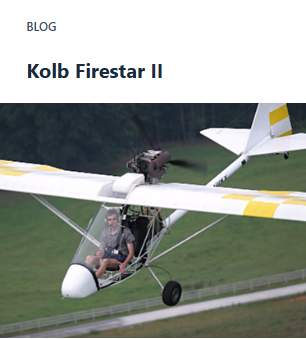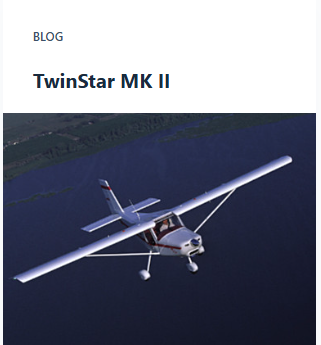When it comes to ultralight aviation, both the Kolb FireStar II and the TwinStar MK II stand out as reliable, high-performance options for sport pilots and enthusiasts. Each aircraft carries the legacy of innovation and efficiency that Kolb and Lockwood are known for — but they serve slightly different needs and flying preferences.
In this FAQ section, we break down the key differences and similarities between these two iconic models from engine setups and flight performance to handling, build complexity, and versatility. Whether you’re a first-time builder or an experienced flyer looking for your next project, this guide will help you decide which aircraft suits your flying style best.
1. What’s the main difference between the Kolb FireStar II and TwinStar MK II?
One of the most noticeable differences between the FireStar II and the TwinStar MK II lies in their seating configurations. The FireStar II features a tandem seating layout, where the second seat is positioned directly behind the pilot and is offered as an optional upgrade. This design helps maintain a narrow fuselage and slightly better aerodynamics. On the other hand, the TwinStar MK II comes standard with side-by-side seating, providing a more spacious and social cockpit experience — ideal for flight training, casual flying with a passenger, or simply enjoying better communication during flight.
2. Which aircraft is better for short-field operations?
When it comes to short-field performance, the TwinStar MK II clearly has the edge over the FireStar II. With a takeoff distance of just 164 feet and a landing distance as short as 131 feet, the MK II proves ideal for tight airstrips, grass runways, and bush flying scenarios. In comparison, the FireStar II requires around 250 feet for takeoff and 300 feet for landing, making it slightly less suited for operations in confined or rugged areas. For pilots who prioritize STOL (Short Takeoff and Landing) capabilities, the TwinStar MK II offers a significant performance advantage
3. Which one is easier to build?
Both the FireStar II and TwinStar MK II are kit-built aircraft designed for homebuilders, with comparable overall build times. The FireStar II typically requires around 350 hours to complete, or approximately 180 hours with the factory’s quick-build option. The TwinStar MK II follows a similar construction process but may take slightly longer due to its side-by-side seating layout and enclosed cockpit, which involve additional components and detailing. Despite the minor difference, both kits are well-documented and builder-friendly, even for first-time aircraft assemblers.
4. Are these aircraft legal for sport pilots?
Yes, both the FireStar II and the TwinStar MK II qualify as Experimental Light Sport Aircraft (ELSA) under FAA regulations. This means they can be legally flown by Sport Pilot license holders, making them accessible to a wider range of recreational pilots. Their low stall speeds, simple handling characteristics, and light construction place them well within the criteria set for light sport aircraft in the U.S.
5. How fast do these aircraft fly?
In terms of speed, the TwinStar MK II outperforms the FireStar II by a noticeable margin. The FireStar II cruises comfortably at around 70 mph, with a top speed of 85 mph. In comparison, the TwinStar MK II offers a faster cruise speed of 81 mph and can reach a top speed of 106 mph. This makes the MK II a better choice for longer cross-country flights or pilots who simply prefer a quicker ride without sacrificing stability or control.
6. Which one has better visibility?
Both the FireStar II and TwinStar MK II offer excellent visibility, thanks to their pusher engine configurations that eliminate obstruction in the forward view. However, the FireStar II stands out with its more open cockpit feel. Pilots can opt for an open cockpit version or add a clear Lexan roof panel, enhancing the sense of openness and providing an immersive flying experience. While the TwinStar MK II also delivers great all-around visibility, its enclosed side-by-side cockpit offers a more sheltered, comfortable ride—especially in cooler conditions.
7. Do both aircraft have folding wings?
Yes, both the FireStar II and TwinStar MK II are designed with practicality in mind, featuring folding wings and tail sections. This allows owners to easily store the aircraft in a standard garage or transport it on a trailer without the need for hangar space. The folding process can typically be done by one person in under 20 minutes, making both models highly convenient for pilots who value flexibility and portability.
8. How much weight can they carry?
The TwinStar MK II has a clear edge in payload capacity, offering about 551 lbs compared to the FireStar II’s 400 lbs. This makes it more suitable for carrying two full-sized adults, extra gear, or fuel for longer trips without compromising performance.
9. Which is better for a beginner pilot?
The TwinStar MK II comes equipped with a tricycle landing gear setup, which offers more stable and forgiving ground handling—especially during takeoff and landing. This configuration can be more beginner-friendly compared to the traditional taildragger setup. That said, both the FireStar II and TwinStar MK II are known for their gentle flight characteristics and responsive controls, making them accessible and enjoyable for new pilots with proper training and transition time.

